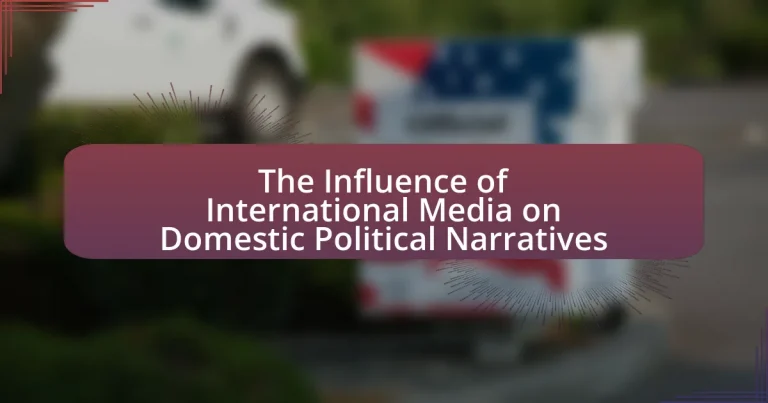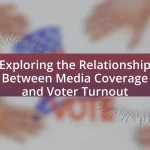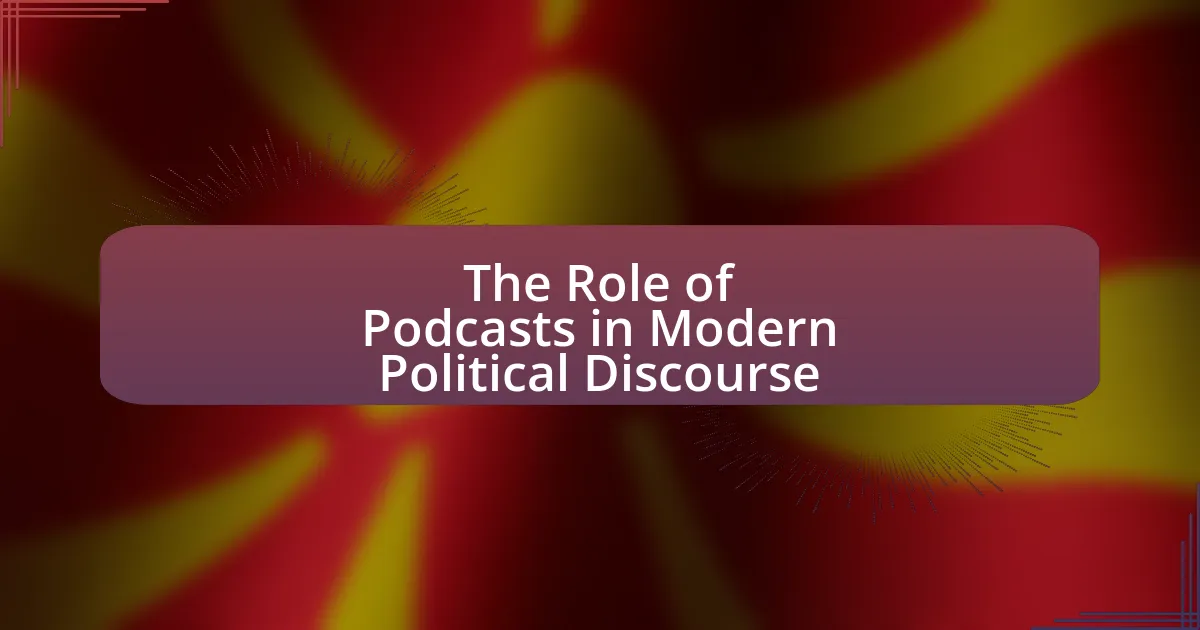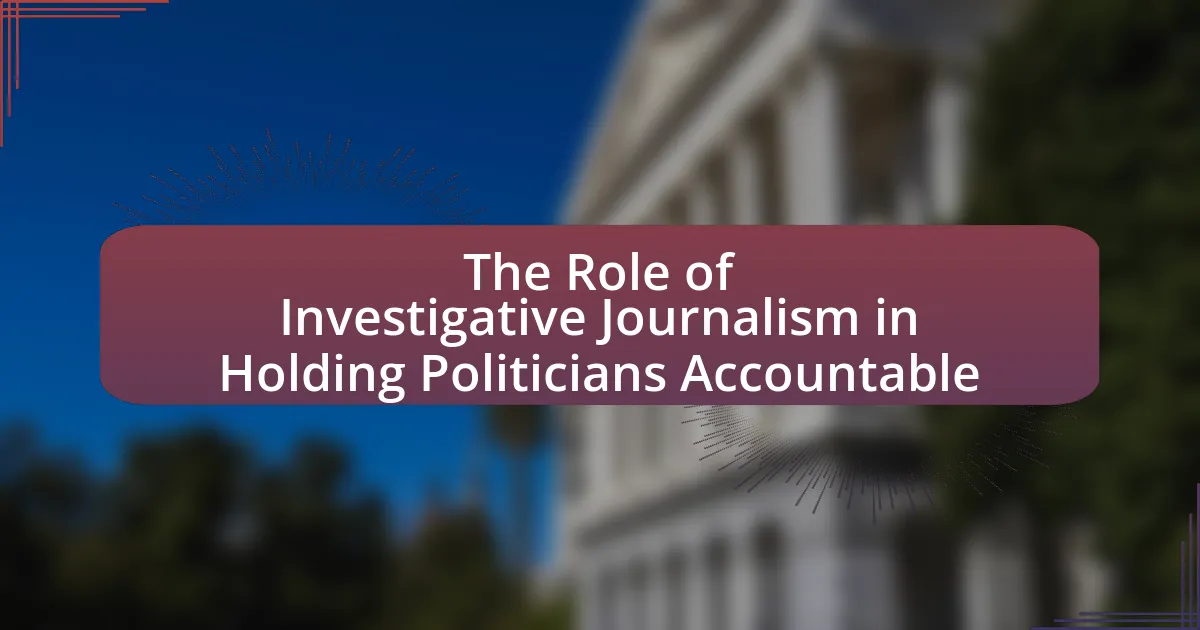The article examines the influence of international media on domestic political narratives, highlighting how global news coverage shapes public perception and political discourse within local contexts. It discusses mechanisms such as framing, agenda-setting, and the dissemination of information that enable international media to alter local narratives. The article also addresses the impact of cultural differences, audience demographics, and education on the reception of international media, as well as the challenges posed by misinformation and biased reporting. Historical examples, including the Vietnam War and the Arab Spring, illustrate the significant role international media plays in shaping political landscapes and public opinion. Additionally, it explores strategies for mitigating negative influences, such as media literacy programs and fact-checking initiatives, to foster a more informed citizenry.

What is the Influence of International Media on Domestic Political Narratives?
International media significantly shapes domestic political narratives by providing alternative perspectives and framing issues that may not be covered by local outlets. This influence is evident in how international news coverage can highlight human rights abuses, economic disparities, or political corruption, prompting domestic audiences to question their government’s actions. For instance, the coverage of the Arab Spring by international media outlets played a crucial role in mobilizing public opinion and protests in various countries, demonstrating the power of external narratives to inspire domestic political change. Additionally, studies show that exposure to international media correlates with increased political awareness and engagement among citizens, further illustrating its impact on shaping local political discourse.
How does international media shape political perceptions in domestic contexts?
International media shapes political perceptions in domestic contexts by providing alternative narratives and framing issues that influence public opinion and political discourse. For instance, coverage of international events, such as elections or protests, can highlight specific aspects that resonate with domestic audiences, thereby altering their understanding of local political dynamics. Research indicates that exposure to international media can lead to shifts in public attitudes, as seen during the Arab Spring, where global media coverage galvanized local movements by framing them as part of a larger struggle for democracy. This demonstrates that international media not only informs but also actively participates in shaping the political landscape within domestic contexts.
What are the mechanisms through which international media influences local narratives?
International media influences local narratives primarily through framing, agenda-setting, and the dissemination of information. Framing occurs when international media presents events or issues in a particular way, shaping how local audiences perceive them. For instance, the portrayal of protests in a country can either emphasize violence or peaceful demonstrations, affecting public opinion and local discourse. Agenda-setting refers to the ability of international media to highlight specific topics, making them more salient in local discussions. Research by McCombs and Shaw (1972) demonstrated that media coverage can significantly influence what audiences consider important. Additionally, the dissemination of information through international news outlets can introduce new perspectives and narratives that local media may adopt or react to, thereby altering the local narrative landscape.
How do cultural differences affect the reception of international media?
Cultural differences significantly affect the reception of international media by shaping audience interpretations and responses. For instance, values, beliefs, and social norms inherent in a culture influence how media content is perceived; what is humorous or acceptable in one culture may be offensive in another. Research by Hofstede (1980) on cultural dimensions highlights that individualism versus collectivism can alter how messages are received, with collectivist cultures often prioritizing group harmony over individual expression, leading to different interpretations of the same media content. Additionally, language barriers and contextual understanding can further complicate the reception, as idiomatic expressions or cultural references may not translate effectively, resulting in misinterpretation. Thus, cultural frameworks play a crucial role in determining how international media is understood and integrated into local political narratives.
Why is the role of international media significant in shaping political discourse?
The role of international media is significant in shaping political discourse because it provides diverse perspectives that influence public opinion and policy decisions. International media outlets often cover global events and issues that may be overlooked by domestic media, thereby broadening the narrative landscape. For instance, during the Arab Spring, international media played a crucial role in highlighting protests and government responses, which affected international perceptions and domestic political actions in various countries. This influence is further evidenced by studies showing that exposure to international news correlates with increased civic engagement and awareness among citizens, ultimately impacting political discourse and decision-making processes.
What historical examples illustrate the impact of international media on domestic politics?
The Vietnam War exemplifies the significant impact of international media on domestic politics, as televised coverage influenced public opinion and policy decisions in the United States. Graphic images and reports of the war’s brutality broadcasted by networks like CBS and NBC led to widespread anti-war sentiment, ultimately pressuring the U.S. government to withdraw troops. Another example is the Arab Spring, where social media platforms like Twitter and Facebook played crucial roles in mobilizing protests and shaping political discourse across the Middle East, leading to regime changes in countries such as Tunisia and Egypt. These instances demonstrate how international media can alter domestic political landscapes by shaping public perception and influencing governmental actions.
How do international media narratives differ from domestic media narratives?
International media narratives often emphasize global perspectives and broader geopolitical contexts, while domestic media narratives focus on local issues and cultural specifics. For instance, international media may frame a political event in terms of its implications for international relations, such as how a country’s election affects regional stability, whereas domestic media typically highlight the immediate impact on citizens, local policies, and community reactions. This difference is evident in coverage of events like the Arab Spring, where international outlets analyzed the implications for global democracy, while domestic outlets concentrated on the local protests and their effects on daily life.

What are the key factors that determine the influence of international media?
The key factors that determine the influence of international media include the reach and accessibility of media platforms, the credibility and reputation of the media outlets, the cultural relevance of the content, and the political context in which the media operates. The reach and accessibility of platforms, such as social media and satellite television, enable international media to disseminate information widely, impacting public opinion across borders. Credibility and reputation are crucial, as audiences are more likely to trust and be influenced by established media organizations with a history of reliable reporting. Cultural relevance ensures that the content resonates with local audiences, making it more impactful. Lastly, the political context, including government regulations and media freedom, can either enhance or restrict the influence of international media, as seen in countries with strict media controls where foreign narratives may be suppressed.
How do audience demographics affect the impact of international media?
Audience demographics significantly affect the impact of international media by shaping how content is received and interpreted. Different age groups, cultural backgrounds, and socioeconomic statuses influence audience preferences, leading to varied responses to the same media message. For instance, younger audiences may engage more with digital platforms, while older demographics might prefer traditional media, affecting the reach and effectiveness of international narratives. Research indicates that cultural context plays a crucial role; a study by the Pew Research Center found that individuals from collectivist cultures are more likely to resonate with media that emphasizes community and social harmony, while those from individualistic cultures may respond better to messages highlighting personal achievement. This demographic variability ultimately determines how international media influences domestic political narratives, as the same content can evoke different reactions based on the audience’s characteristics.
What role does education play in interpreting international media messages?
Education plays a crucial role in interpreting international media messages by equipping individuals with critical thinking skills and media literacy. These skills enable people to analyze, evaluate, and understand the context and biases present in media content. Research indicates that higher levels of education correlate with improved ability to discern credible information from misinformation, as educated individuals are more likely to question sources and seek diverse perspectives. For instance, a study by the Pew Research Center found that individuals with a college degree are more adept at identifying factual information in news articles compared to those with lower educational attainment. This ability to critically assess international media messages ultimately influences how domestic political narratives are shaped and understood.
How does access to technology influence media consumption patterns?
Access to technology significantly influences media consumption patterns by enabling greater access to diverse content and platforms. With the proliferation of smartphones and high-speed internet, individuals can easily access news, entertainment, and social media from anywhere, leading to an increase in on-demand viewing and a shift away from traditional broadcast media. For instance, a Pew Research Center study found that 53% of U.S. adults often get news from social media, highlighting a shift in how information is consumed. This access allows users to curate their media experiences, often leading to echo chambers where individuals are exposed primarily to viewpoints that align with their own, thereby shaping political narratives and public opinion.
What types of international media content are most influential?
The most influential types of international media content include news broadcasts, documentaries, and social media platforms. News broadcasts, particularly from reputable global networks like BBC and CNN, shape public opinion by providing timely updates on international events, which can influence domestic political narratives. Documentaries often present in-depth analyses of global issues, fostering understanding and empathy among viewers, thereby impacting their political perspectives. Social media platforms, such as Twitter and Facebook, facilitate the rapid dissemination of information and opinions, allowing users to engage with international content that can sway political beliefs and mobilize action. Research indicates that exposure to diverse international media content correlates with increased political awareness and engagement among audiences, highlighting its significant influence on domestic political narratives.
How do news reports compare to opinion pieces in shaping political narratives?
News reports and opinion pieces shape political narratives differently, with news reports focusing on factual reporting and opinion pieces emphasizing subjective viewpoints. News reports aim to provide objective information, often backed by data and verified sources, which helps establish a baseline understanding of political events. For example, a news report on an election might include statistics on voter turnout and official statements from candidates, thereby informing the public without bias. In contrast, opinion pieces present interpretations and arguments, often reflecting the author’s perspective, which can influence public perception and debate. Research indicates that opinion pieces can sway readers’ beliefs more significantly than news reports due to their persuasive nature, as seen in studies showing that editorial content can shift public opinion on issues like climate change or healthcare policy. Thus, while news reports lay the groundwork for understanding, opinion pieces actively shape and challenge political narratives.
What is the impact of social media on the dissemination of international news?
Social media significantly accelerates the dissemination of international news by enabling real-time sharing and broad audience reach. Platforms like Twitter and Facebook allow users to instantly share news articles, videos, and live updates, which can lead to rapid spread and engagement across diverse demographics. According to a Pew Research Center study, 53% of U.S. adults report getting news from social media, highlighting its role as a primary news source. Furthermore, social media facilitates the viral nature of news, where a single post can reach millions within hours, influencing public opinion and political narratives globally.
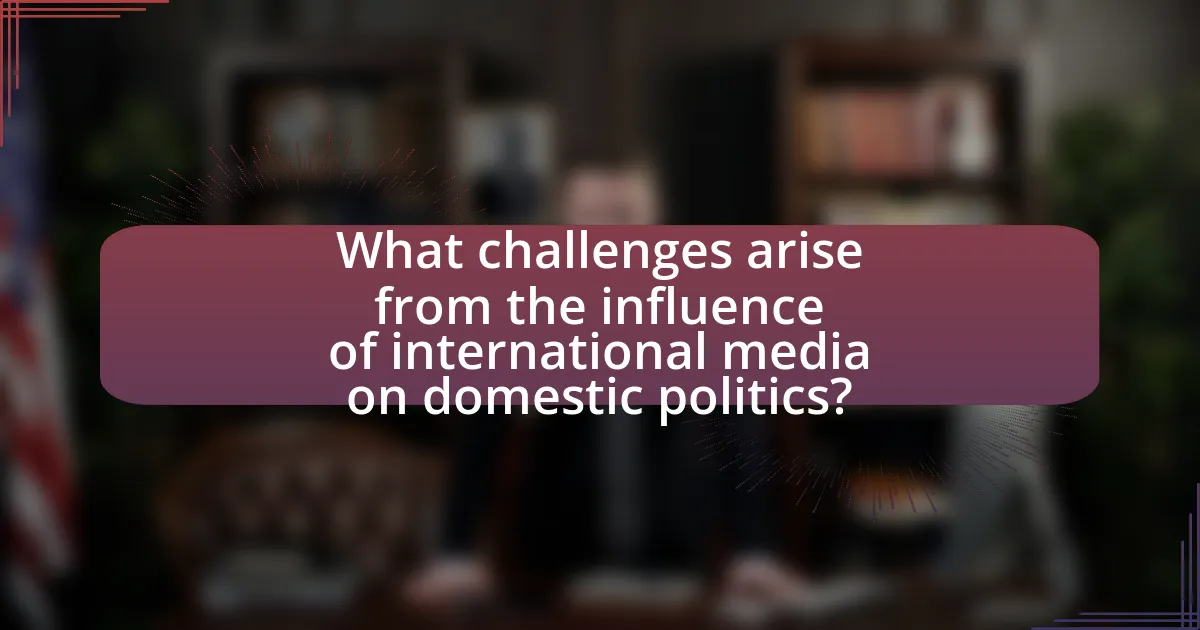
What challenges arise from the influence of international media on domestic politics?
The challenges arising from the influence of international media on domestic politics include the potential for misinformation, the undermining of local narratives, and the polarization of public opinion. Misinformation can spread rapidly through international media channels, leading to confusion and distrust among the populace. For instance, during the Arab Spring, international media coverage often misrepresented local contexts, which complicated political responses and public understanding. Additionally, international media can overshadow local voices, creating a narrative that may not reflect the true sentiments of the domestic population, as seen in various conflicts where foreign reporting prioritized sensationalism over accuracy. This can lead to increased polarization, as citizens may align more strongly with either the international narrative or their local perspectives, further dividing the political landscape.
How can misinformation from international media affect political stability?
Misinformation from international media can significantly undermine political stability by fostering public distrust in government institutions and inciting social unrest. When false narratives are disseminated, they can lead to misinformed public perceptions, which may result in protests, political polarization, and even violence. For example, during the Arab Spring, international media coverage often amplified misinformation about government actions, which contributed to widespread protests and regime changes in several countries. This illustrates how international media can shape domestic political landscapes, leading to instability when misinformation is prevalent.
What are the consequences of biased reporting on public opinion?
Biased reporting significantly distorts public opinion by shaping perceptions and beliefs based on selective information. This distortion can lead to polarization, where individuals align more closely with extreme viewpoints, as evidenced by studies showing that exposure to biased media increases ideological divides among audiences. Furthermore, biased reporting can undermine trust in media institutions, as audiences may become skeptical of information sources perceived as untrustworthy, leading to a decline in civic engagement and informed decision-making. Research indicates that when media outlets present information in a biased manner, it can result in misinformed public perceptions about critical issues, such as immigration or climate change, ultimately affecting policy support and electoral outcomes.
How do governments respond to perceived threats from international media narratives?
Governments respond to perceived threats from international media narratives by implementing strategies such as censorship, public relations campaigns, and regulatory measures. For instance, countries like China and Russia have enacted laws to control foreign media content and promote state-sponsored narratives, aiming to mitigate the influence of international reporting that contradicts their political agendas. Additionally, governments may engage in diplomatic efforts to counter negative portrayals, as seen in instances where officials publicly refute claims made by foreign media, thereby attempting to shape public perception domestically. These actions are often justified by citing national security concerns or the need to protect cultural integrity, demonstrating a proactive approach to managing the impact of international media on domestic political narratives.
What strategies can be employed to mitigate negative influences of international media?
To mitigate negative influences of international media, governments and organizations can implement media literacy programs that educate citizens on critical consumption of news. These programs empower individuals to discern bias and misinformation, fostering a more informed public. Research indicates that media literacy can significantly reduce susceptibility to propaganda and misleading narratives, as evidenced by studies showing improved critical thinking skills among participants (Hobbs, 2010, “Digital and Media Literacy: A Plan of Action”). Additionally, promoting diverse local media outlets can provide alternative perspectives, countering the dominance of international narratives. Supporting local journalism through funding and training enhances the quality and reach of domestic reporting, which can effectively challenge negative portrayals in international media.
How can media literacy programs empower citizens to critically evaluate media content?
Media literacy programs empower citizens to critically evaluate media content by equipping them with the skills to analyze, assess, and create media messages. These programs teach individuals to recognize bias, identify misinformation, and understand the techniques used in media production, which enhances their ability to discern credible sources from unreliable ones. Research indicates that participants in media literacy initiatives demonstrate improved critical thinking skills and a greater awareness of media influence on public perception and political narratives. For instance, a study by the National Association for Media Literacy Education found that students who engaged in media literacy education were better able to evaluate the credibility of news sources and understand the impact of media framing on their opinions.
What role do fact-checking organizations play in countering misinformation?
Fact-checking organizations play a crucial role in countering misinformation by verifying claims and providing accurate information to the public. These organizations assess the validity of statements made by public figures, media outlets, and social media posts, often using a systematic approach that includes sourcing, evidence evaluation, and contextual analysis. For instance, according to a study by the Pew Research Center, fact-checking can significantly reduce the spread of false information, as individuals exposed to fact-checked content are more likely to correct their misconceptions. This process not only helps to inform the public but also holds media and political entities accountable, thereby fostering a more informed citizenry and enhancing the integrity of public discourse.
What best practices can be adopted for engaging with international media?
To effectively engage with international media, organizations should prioritize clear communication, cultural sensitivity, and timely responses. Clear communication ensures that messages are easily understood across diverse audiences, while cultural sensitivity helps in tailoring messages that resonate with different cultural contexts. Timely responses to media inquiries demonstrate professionalism and build trust. According to a study by the Pew Research Center, 63% of journalists value timely information, indicating that prompt engagement can significantly enhance media relations.
How can individuals discern credible sources from unreliable ones?
Individuals can discern credible sources from unreliable ones by evaluating the source’s authority, accuracy, objectivity, and currency. Credible sources typically have established expertise in their field, provide evidence-based information, maintain neutrality, and are up-to-date with current events. For instance, academic journals and reputable news organizations often undergo rigorous editorial processes, ensuring the reliability of their content. In contrast, sources lacking transparency, such as personal blogs or unverified social media accounts, may present biased or inaccurate information. Research indicates that individuals who critically assess these factors are more likely to identify trustworthy information, as highlighted in studies on media literacy conducted by the Pew Research Center.
What steps can policymakers take to foster a healthy media environment?
Policymakers can foster a healthy media environment by implementing regulations that promote transparency, diversity, and accountability in media ownership. For instance, establishing clear guidelines for media ownership can prevent monopolies, ensuring a variety of voices and perspectives are represented. Research indicates that diverse media ownership correlates with a more informed public, as seen in studies by the Pew Research Center, which highlight that communities with multiple media outlets have higher engagement in civic activities. Additionally, policymakers can support public funding for independent journalism, which has been shown to enhance the quality of reporting and reduce reliance on sensationalism. By prioritizing these steps, policymakers can create a media landscape that supports democratic discourse and informed citizenry.
